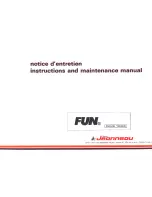
1-2
190 Outrage
Section 1• Safety
R
Boat position-secure on trailer
Tiedowns-tight
Winch-locked
Trailer
hitch-connected
Engine clearance-in trailering position
Safety
chains-attached
Electrical-Lights, brake lights, turn signals
working
Mirrors-adjusted for trailering
Update checklists when equipment is added or
modifi ed.
Weather-forecast
safe
Required documents-on board
Navigation charts & equipment-on board
Safety equipment-on board
Safety training-passengers & crew instructed
on procedures, location, and use of safety
equipment.
Drain
plugs-installed
Bilge pumps-working & clean
Blower-working
Navigation
lights-working
Horn-working
Fuel system-no leaks or fumes
Fuel
fi lter-tight & clean
Power
steering
fl uid-fi lled(if applicable)
Steering system-working smoothly & properly
Battery-electrolyte level within range
Float
plan-fi led with friend or relative
Safe Boating Checklist
Before Departure
Trailering (if applicable)
After Return
PFD’s & other safety gear-dry, stowed for
next
use
Fuel
tanks-fi lled (allow for expansion) to
prevent
condensation
Fuel system-no leaks
Bilge pump-operating properly
Bilge-clean, no leaks
Float plan-notify person with whom you
fi led plan
SAFE Boating means:
• Knowing the limitations of your boat
• Following the “RULES of the ROAD”
• Keeping a sharp lookout for people and objects
in the water.
• Not boating in water or weather conditions that
are beyond the boat’s and operator’s capability.
• Never operating the boat while under the
infl uence of drugs or alcohol.
• Being aware of your passengers safety at all
times.
• Reducing speed when there is limited visibility,
rough water, people in the water nearby , boats
or
structures.
In Addition:
• Maintain your boat and its safety and other
systems as recommended in this manual.
• Have the boat inspected by a qualifi ed
mechanic or dealer, at least annually.
• Ensure that the Coast Guard required safety
equipment is on board and functioning.
Boating in beautiful weather and calm water
conditions can be a wonderful experience. Boating
however requires considerably greater skills than
operating a land vehicle. Taking a boating course
is the best way to prepare for a safe and enjoyable
experience on the water.
• Take a Coast Guard, U.S. Power Squadron or
equivalent boating safety course. (Call
the Boat/U.S. Foundation at 1-800 336-2628
for information on available courses, or go to:
“www.boatus.com/foundation” on the internet.)
• Get hands-on training on how to operate your
boat
properly.
As a boat owner or operator, YOU are responsible
for your safety and the safety of your passengers
and other boaters.
NOTICE
Summary of Contents for 190 Outrage
Page 2: ......
Page 12: ...xii 190 Outrage R THIS PAGE INTENTIONALLY LEFT BLANK ...
Page 54: ...2 22 190 Outrage Section 2 General Information R THIS PAGE INTENTIONALLY LEFT BLANK ...
Page 69: ...4 5 190 Outrage Section 4 Electrical System R Switch Instrument Panel Schematic Fig 4 5 1 ...
Page 70: ...4 6 190 Outrage Section 4 Electrical System R Hull Wiring Diagram Fig 4 6 1 ...















































